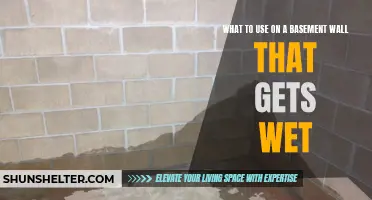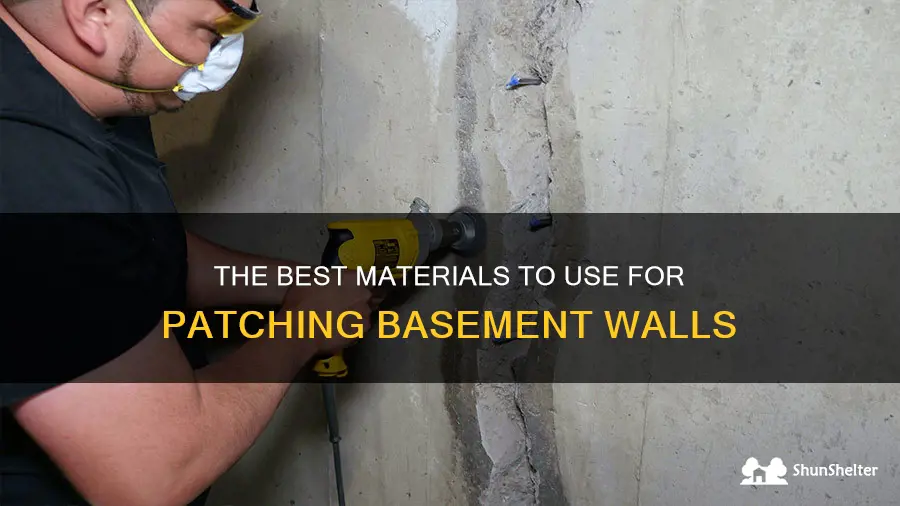
Patching basement walls can be a cumbersome and time-consuming task, especially when faced with cracks, holes, or other damages. However, having the right tools and materials at your disposal can make the process much more manageable. From specialized patching compounds and sealants to sturdy trowels and brushes, this guide will explore the essential items you need to effectively patch your basement walls. So, whether you're looking to repair minor damages or undertake a full-scale renovation, read on to discover the best tools and materials to ensure your basement walls not only look brand new but also stand the test of time.
| Characteristics | Values |
|---|---|
| Material | Cement-based patching compound, hydraulic cement, or epoxy mortar |
| Purpose | Filling cracks, holes, or voids in basement walls |
| Waterproofing | Should have waterproofing properties to prevent water seepage |
| Flexibility | Should have some degree of flexibility to accommodate slight movements |
| Adhesion | Strong adhesion to ensure the patch stays in place |
| Durability | Should be durable and long-lasting |
| Setting time | Quick-setting options available for immediate results |
| Easy application | Should be easy to mix, apply, and smooth out |
| Paintability | Should be suitable for painting over once dry |
| Mold resistance | Preferred to have mold-resistant properties to prevent mold growth |
| Chemical resistance | Should withstand exposure to chemicals and moisture |
| Cost | Consider cost-effectiveness and available budget |
| Safety | Ensure the product is safe to use and does not emit harmful fumes or particles |
What You'll Learn

Common materials for patching basement walls
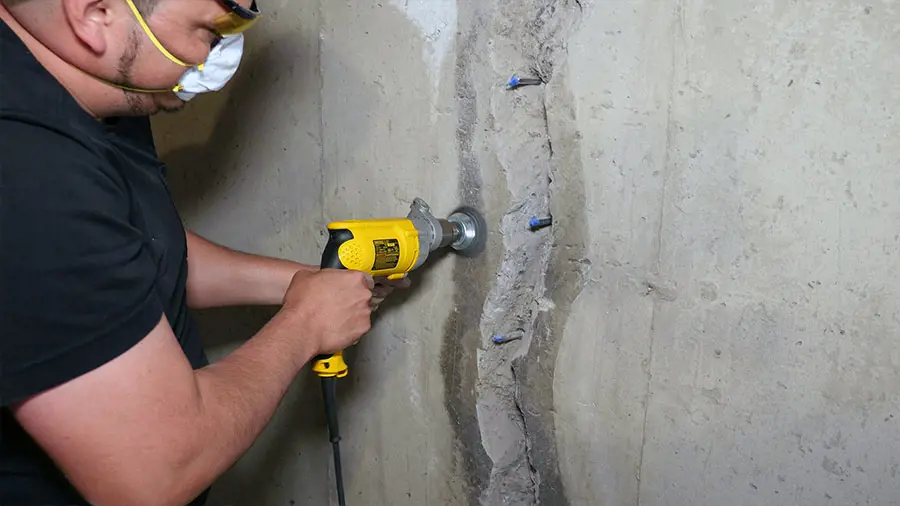
The basement is an essential part of any home, providing valuable storage space and potentially even serving as an additional living area. But over time, basement walls can develop cracks or other damage that needs to be repaired. Patching these walls is an important maintenance task that can help prevent further damage and keep your basement in good condition. Here are some common materials that you can use to patch basement walls:
- Hydraulic cement: Hydraulic cement is a popular choice for patching basement walls due to its excellent bonding strength and resistance to water. It is a quick-setting cement that can be mixed with water to form a paste, which can then be applied directly to the damaged area. Hydraulic cement is effective for both interior and exterior wall repairs and can be used to fill cracks, holes, and other types of damage.
- Epoxy: Epoxy is a two-part adhesive that is known for its strength and durability. It is an ideal choice for patching larger cracks or holes in basement walls. To use epoxy for wall repairs, you will need to mix the two components together according to the manufacturer's instructions. Once mixed, the epoxy can be applied to the damaged area using a putty knife or similar tool. Epoxy is resistant to water and can provide a long-lasting repair solution for basement walls.
- Patching compound: Patching compound, also known as wall filler or spackle, is a versatile material that can be used to patch small cracks and holes in basement walls. It is easy to work with and can be applied directly to the damaged area with a putty knife or a trowel. Patching compound dries quickly and can be sanded smooth once it is fully cured. It is important to note that patching compound is not suitable for repairs in areas that are prone to moisture, as it can deteriorate over time.
- Concrete mix: For more extensive repairs or if you need to rebuild a section of your basement wall, using a concrete mix may be necessary. Concrete mix is a combination of cement, sand, and gravel, which can be mixed with water to form a workable paste. It can be used to fill large holes, rebuild damaged sections of the wall, or create a new concrete surface. When using concrete mix, it is important to follow the manufacturer's instructions and ensure that the mixture is properly mixed and applied.
Before starting any patching project, it is important to thoroughly clean and prepare the damaged area. Remove any loose debris or old patching material, and make sure the surface is clean and dry. Additionally, if you suspect that the damage to your basement wall is due to underlying issues such as structural problems or water leakage, it is recommended to consult a professional before attempting any repairs.
Patching basement walls is a straightforward process that can be done by homeowners with basic DIY skills. By selecting the right materials and following the proper techniques, you can effectively repair cracks and damage and ensure the longevity of your basement walls.
The Best Products for Damp Proofing Basement Walls: A Comprehensive Guide
You may want to see also

Factors to consider when choosing a patching material
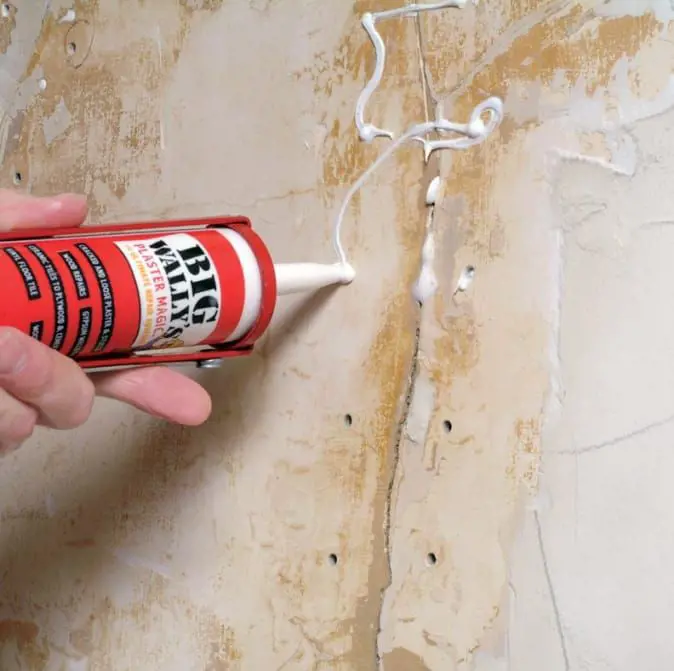
When it comes to patching basement walls, it is important to choose the right material for the job. The material you choose will determine the success and longevity of your repair. There are several factors to consider when choosing a patching material for basement walls.
- Water resistance: Basements are prone to moisture and water damage, so it is important to choose a patching material that is water resistant. Look for products that are specifically designed for basement walls and have waterproofing properties. These materials will help prevent future water damage and ensure that your repair lasts.
- Strength and durability: Basement walls are typically made of concrete or masonry, so you need a patching material that can withstand the stress and pressure that these materials endure. Look for materials that are specifically formulated for concrete or masonry repair and have high strength and durability ratings. This will ensure that your repair is strong and long-lasting.
- Ease of application: Patching basement walls can be a labor-intensive task, so it is important to choose a material that is easy to apply. Look for patching materials that come in a ready-to-use form or can be mixed easily. This will save you time and effort during the repair process.
- Adhesion properties: The patching material you choose should have strong adhesion properties to ensure that it bonds well with the existing wall surface. Look for products that have good adhesion ratings and can stick to a variety of surfaces, including concrete, masonry, and even painted walls. This will ensure that your repair is secure and long-lasting.
- Appearance: While the main goal of patching basement walls is to fix structural issues, it is also important to choose a material that will blend in with the existing wall surface. Look for patching materials that can be easily painted or have a neutral color that matches the surrounding area. This will help ensure that your repair is visually appealing and seamless.
In conclusion, when choosing a patching material for basement walls, it is important to consider factors such as water resistance, strength and durability, ease of application, adhesion properties, and appearance. By taking these factors into account, you can ensure that your repair is successful and long-lasting.
Effective Solutions for Covering Basement Wall Cracks
You may want to see also

Step-by-step guide for patching basement walls
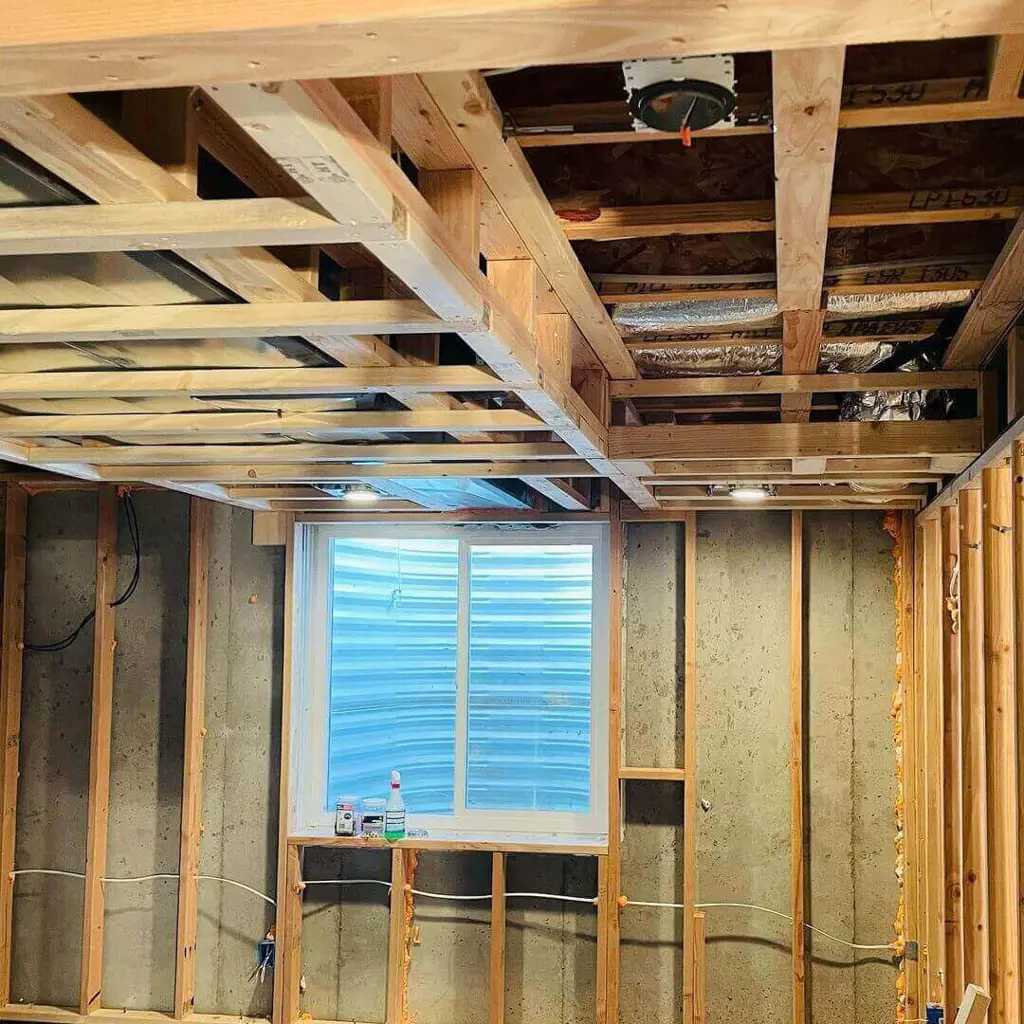
Is your basement wall in need of some repairs? Maybe you've noticed cracks, holes or other damage that needs to be addressed. Don't worry! With the right tools and materials, you can easily patch your basement walls and restore their integrity. In this step-by-step guide, we will walk you through the process of patching your basement walls.
Step 1: Gather your materials
Before you begin, make sure you have all the necessary tools and materials. Here's a list of what you'll need:
- Safety goggles
- Dust mask
- Gloves
- Wire brush or scraper
- Hammer and chisel
- Vacuum cleaner
- Masonry patching compound
- Trowel
- Paintbrush
- Sandpaper
Step 2: Prepare the area
First, ensure that the area you'll be patching is clean and free of loose debris. Use a wire brush or scraper to remove any loose paint, dirt or chipped mortar from the surface. This will help the patching compound adhere better to the wall.
Step 3: Remove loose or damaged material
Next, use a hammer and chisel to carefully remove any loose or damaged material from the wall. Be sure to wear safety goggles and gloves to protect yourself from flying debris. Use the chisel to create clean edges around the damaged area, removing any loose or crumbling material. Once you've removed the damaged material, vacuum the area to remove any remaining dust or debris.
Step 4: Apply the patching compound
Now it's time to apply the patching compound. Mix the masonry patching compound according to the manufacturer's instructions. Using a trowel, apply the compound to the damaged area, filling it in and smoothing it out. Make sure the compound is level with the surrounding wall surface. If needed, apply multiple layers of the compound, allowing each layer to dry before applying the next.
Step 5: Sand and paint
Once the patching compound is completely dry, you may need to sand it to ensure a smooth finish. Use sandpaper to gently sand the patched area until it's even with the surrounding wall surface. Be careful not to sand too aggressively, as this can damage the patch. Once you're satisfied with the smoothness, wipe away any dust with a clean, dry cloth.
Finally, you can apply a coat of paint to the patched area to match the rest of the wall. Use a paintbrush and apply the paint in smooth, even strokes. Allow the paint to dry completely before considering the job complete.
And there you have it – a step-by-step guide for patching your basement walls. By following these instructions and using the right tools and materials, you can effectively repair any damage and restore the integrity of your basement walls. Remember, safety always comes first, so be sure to wear the appropriate protective gear and work carefully. Good luck with your basement wall repairs!
A Step-by-Step Guide on Tiling a Basement Wall
You may want to see also

Tips for maintaining and preventing future damage to basement walls
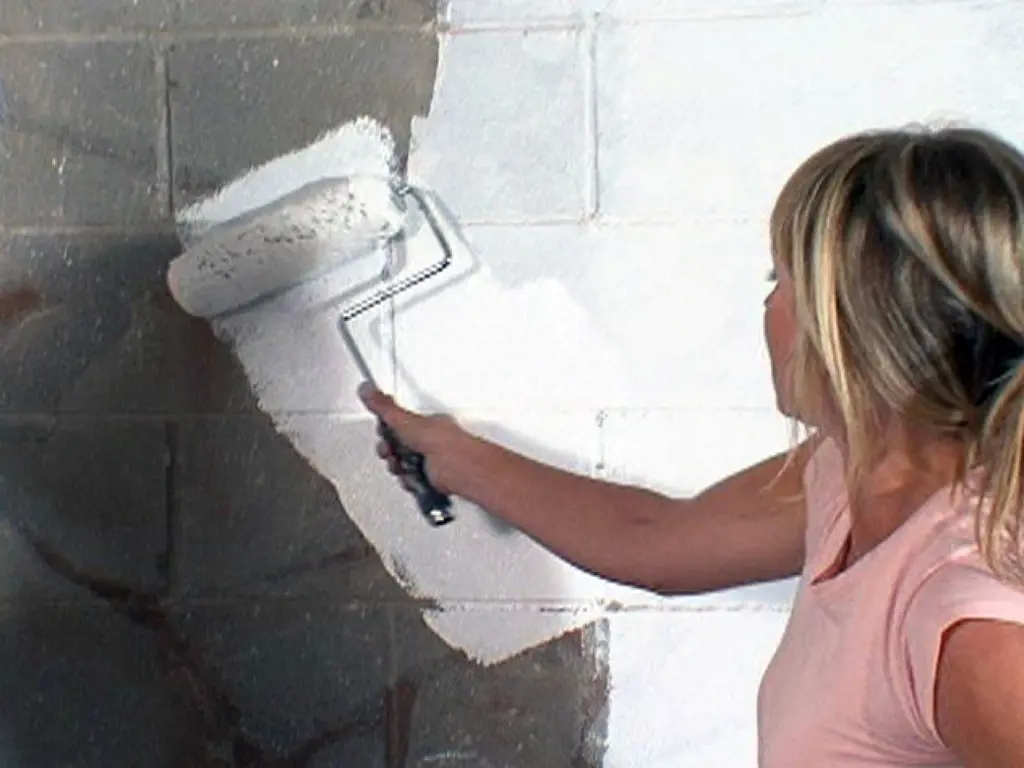
Your basement walls are an essential part of your home's foundation, and it's crucial to properly maintain them to prevent any damage. If you notice cracks or other forms of damage on your basement walls, it's important to address them promptly to prevent further issues. In this article, we will discuss some tips for maintaining and preventing future damage to your basement walls.
Regularly inspect your basement walls:
- Make it a habit to inspect your basement walls at least once a year. Look for any signs of cracks, moisture, or discoloration.
- Pay attention to any areas where water may be seeping in, such as around pipes, windows, and door openings.
- If you notice any damage or potential issues, it's important to address them sooner rather than later.
Fix small cracks and leaks promptly:
- Small cracks in your basement walls can lead to bigger problems if left unattended. It's important to fix these cracks as soon as you notice them.
- Use an epoxy or polyurethane injection to fill the cracks. These materials are durable and flexible, ensuring a long-lasting repair.
- If you're unsure about how to fix the cracks yourself, it's best to consult a professional who specializes in foundation repair.
Install proper drainage systems:
- One of the main causes of basement wall damage is water accumulation. To prevent this, it's important to install an effective drainage system.
- Ensure that your gutters are clean and properly functioning. They should direct water away from your foundation.
- Consider installing a French drain or a sump pump system. These systems can collect and divert water away from your basement walls, preventing water damage.
Control humidity levels:
- High humidity levels in your basement can lead to moisture buildup and mold growth, which can damage your walls.
- Install a dehumidifier in your basement to control humidity levels. This will help prevent moisture-related issues and keep your walls dry.
Avoid storing water or chemicals near your basement walls:
- If you have a utility area in your basement, make sure to keep any water or chemical containers away from your walls.
- Leakage or accidental spills can damage the walls and lead to long-term issues. Store these items in a safe and dry area to prevent any potential damage.
Maintain proper grading around your foundation:
- Ensure that the ground around your foundation is properly graded. The soil should slope away from your home to prevent water from pooling near your basement walls.
- If you notice any areas where the ground is not properly graded, add soil or make necessary adjustments to ensure proper drainage.
Consider using basement waterproofing products:
- To further protect your basement walls, consider applying a waterproofing product. These products create a barrier that prevents water from seeping through the walls.
- There are various types of waterproofing products available, such as waterproof paint, sealants, and coatings. Choose a product that is suitable for your specific needs and follow the manufacturer's instructions for application.
By following these tips, you can effectively maintain your basement walls and prevent future damage. Regular inspections, prompt repairs, and proactive measures will help ensure the integrity of your basement walls and the overall stability of your home's foundation.
Signs to Identify If Roots are Damaging Basement Walls
You may want to see also
Frequently asked questions
One common option for patching basement walls is hydraulic cement. It is a fast-setting material that can help stop water leaks and fill in cracks.
Regular cement can be used to patch basement walls, but it may not provide the same level of water resistance as hydraulic cement. It is important to choose a cement mix that is specifically designed for basement wall repairs.
Yes, there are other options for patching basement walls. Some homeowners choose to use epoxy or polyurethane injections to fill in cracks and repair damage. These materials can provide added durability and water resistance.
The best method for patching basement walls will depend on the specific needs of your situation. It is recommended to consult with a professional to assess the damage and determine the most effective solution.
If you have experience with home repairs and feel confident in your abilities, you can attempt to patch your basement walls yourself. However, if you are unsure or if the damage is extensive, it is best to hire a professional to ensure the repairs are done correctly and to avoid further damage.


